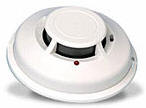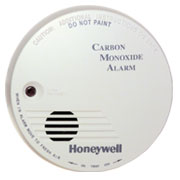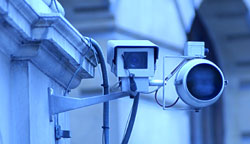Burglar Alarm Systems
............................................................................................................
Security Systems
Security Systems are made up of a control unit usually located in the
basement of a house or the service room of a business. This unit is the
brains behind the system. The system is then turned on or off from a keypad
usually located near the front or exit door. Security systems can have
multiple keypads located at different doors if needed. Each system can be
made up of different types of sensors.
Contacts-are located on doors and windows and detect the door or window
being opened.
-
 Motion
Detectors - detect movement within a certain area or
room. These units
cannot see through walls or glass and are typically located in common areas Motion
Detectors - detect movement within a certain area or
room. These units
cannot see through walls or glass and are typically located in common areas
i.e.: hallways. There are also units that will allow small family pets to move
around without triggering the alarm system.
-
 Shock
Sensors - detect vibration on a window or door. These units are normally
used on a particularly vulnerable window or door. Shock
Sensors - detect vibration on a window or door. These units are normally
used on a particularly vulnerable window or door.
-
 Glass
Break Detectors - detect the noise generated when glass is broken. These
units have a small microphone housed within the unit and can cover multiple
pieces of glass on different windows within the same room or area. Glass
Break Detectors - detect the noise generated when glass is broken. These
units have a small microphone housed within the unit and can cover multiple
pieces of glass on different windows within the same room or area.
-
 Smoke
Detectors - detect smoke within the premises. Normally located one on
each level in the common area or hallway. Smoke
Detectors - detect smoke within the premises. Normally located one on
each level in the common area or hallway.
-
 Heat
Detectors - detect sudden rises of temperature. These units are normally
located in a kitchen or furnace room where smoke detectors cannot be used
with our fear of false alarms. Heat
Detectors - detect sudden rises of temperature. These units are normally
located in a kitchen or furnace room where smoke detectors cannot be used
with our fear of false alarms.
-
 Carbon
Monoxide Detectors - detect carbon monoxide levels on the premises. Carbon
Monoxide Detectors - detect carbon monoxide levels on the premises.
This is measured in parts per million in the surrounding atmosphere. These
units are normally located near appliances that burn gases or wood i.e.:
furnace, water heaters or fire places. They can also be located in bedroom
hallways.
-
Water Sensors - detects water from burst pipes or a sump pump failure. These
sensors are normally used when the premises are left empty for long periods
of time as the monitoring station can react before major water damage
occurs.
-
Low Temperature Sensors - detects a drop in temperature if the furnace fails.
The sensor will trigger an alarm and the monitoring station can react before
the premises gets so cold that water pipes would freeze and burst. These
sensors are also used when the premises are left empty for long periods of
time.
All of the above systems and sensors can be either hard-wired or wireless depending if wiring can be
accommodated at the premises or not. Wireless
sensors are battery-operated with lithium batteries giving an approximate
six to seven year life span.
This
information is a courtesy from Solo Security. Should you require further
information or assistance, please do not hesitate to call Niall Murphy at
(416) 897-0384.
............................................................................................................
|
 Solo
Security
Solo
Security
 Motion
Detectors - detect movement within a certain area or
room. These units
cannot see through walls or glass and are typically located in common areas
Motion
Detectors - detect movement within a certain area or
room. These units
cannot see through walls or glass and are typically located in common areas Shock
Sensors - detect vibration on a window or door. These units are normally
used on a particularly vulnerable window or door.
Shock
Sensors - detect vibration on a window or door. These units are normally
used on a particularly vulnerable window or door. Glass
Break Detectors - detect the noise generated when glass is broken. These
units have a small microphone housed within the unit and can cover multiple
pieces of glass on different windows within the same room or area.
Glass
Break Detectors - detect the noise generated when glass is broken. These
units have a small microphone housed within the unit and can cover multiple
pieces of glass on different windows within the same room or area. Smoke
Detectors - detect smoke within the premises. Normally located one on
each level in the common area or hallway.
Smoke
Detectors - detect smoke within the premises. Normally located one on
each level in the common area or hallway.
